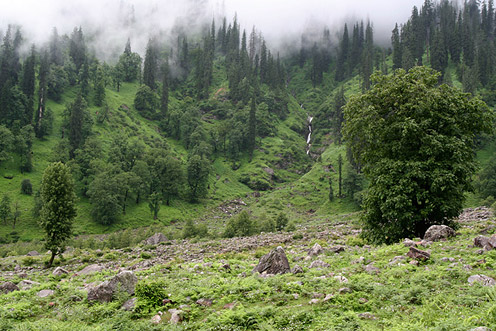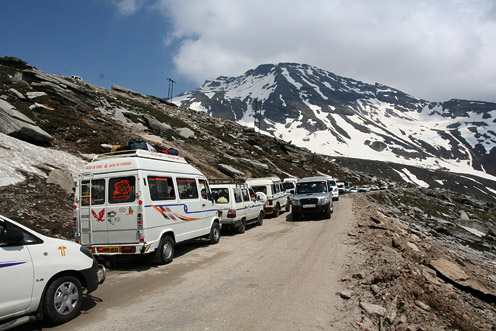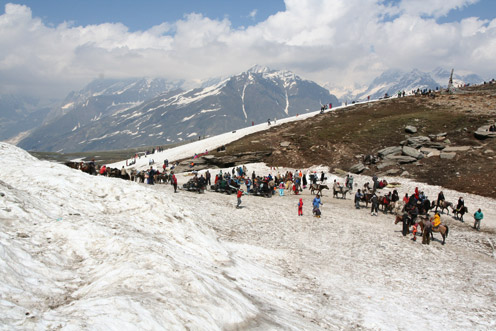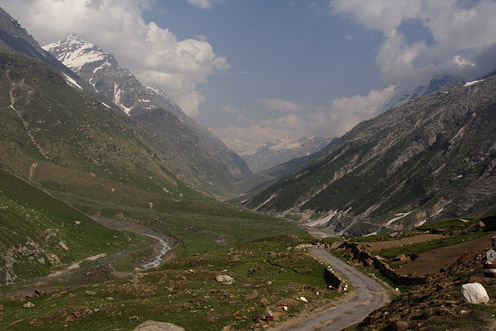People start from Manali at an unearthly hour of 2am. And they keep going and going and going, travelling nearly twenty hours to get to Leh. It seems like a senseless adventure to go in a cramped Tata Sumo in those testing altitudes; It seems like Leh will never come. But people do it: many Sumos leave for Leh everyday, packing passengers from Manali who don’t want to waste a day or spend more money by stopping on the way.

Verdant landscapes of Beas Valley
The initial part of the journey is pleasant. The road runs upstream of Beas River through a green valley, with tall mountains on both sides flaunting coniferous forests on their slopes. It slopes up gently for the first half hour and then steadily increases in gradient. Waterfalls run abundant on the near vertical slopes, emerging out of the snow trapped in depressions. The sheer scale of mountains in these parts are realized by tiny specs of shepherd-tents that look no bigger than a small dot on the slopes. It indeed needs no less than a collision between two continental masses to create formations of this scale and might. Its grandeur, size and fearsome weather can overwhelms the onlooker and instantly earn his or her respect.
The slopes of Manali-Rohtang Pass road remain green through the year in lower regions. The deodar forests give way to shorter vegetation higher up, and eventually it is just green grass spreading thinly on the surface. Streams run all over the place uncontrolled, released from the melting masses of ice. The pass is completely covered in snow in early summer and gradually melts away, with very little of it left when the monsoons arrive. As the first rains come in and snow is drained out from the higher regions, flowers burst out on the slopes, filling up every inch of the mountains with tiny dots of pink and yellow.

The road to Rohtang Pass (File Photo)
The last hour of the journey though, is much more than the romance with the mountain ranges. The rush of tourists in search of snow creates frequent traffic jams on the way up. Unmetalled surface can be slushy and hard to navigate. The thin mountain air and the half burnt diesel emissions from the pile of vehicle heading up is not exactly pleasant. It looks no different from peak hour traffic in congested roads of our cities, save for the views of the mountains here.
Tourists at Rohtang Pass (File Photo)
In summer months when there is still snow, Rohtang attracts large crowds excited about the snow. It’s a mad tourist trap that takes in thousands of people, followed by hundreds of vendors trying to keep the tourists comfortable and happy. The plateau on the pass turns into a big market place with long lines of shacks selling things from Aloo Paratha to skiing lessons. But later in the season when the slopes are bare (this is when the Ladakh season begins, in late June), there are just a handful of optimistic tourists searching for last of the snow.
Beyond Rohtang: Chandra Valley in Lahaul (File Photo)
However, there is a sea change in atmosphere on getting past Rohtang and entering into the valley of Chandra river in Lahaul region. The greenery that kept comapny disappears suddenly and the slopes appear brown and arid. Dhauladhar mountains (the mountain range that hosts Rohtang Pass) keep the monsoon at bay, allowing little precipitation and extending the summer days until October. The mass of tourists, the traffic and commotion dies down and makes way to silence. Verdant landscapes of Beas Valley make way to a stark beauty that has no parallels to scenery witnessed so far. It is here that the traveller begins to see first glimpses of barren landscape that Ladakh is, though Ladakh itself is still far away.
Travelling in Himachal in June – 2007
Shimla >> Manali >> Rohtang >> Chandratal >> Ki/Kibber/Tabo >> Kalpa >> Shimla
+ Previous: Exploring Solang Nala
+ Next: Our Driver Mangal
+ Go to beginning of the story or index page
The later half of the title is borrowed from an Eric Clapton number in City of Angels OST.
Leaving Manali, we made our way up to Rohtang, and beyond to Lahaul Valley.
Manali nearly has the feel of end of civilization, beyond which one would expect higher inaccessible passes and plateaus that are referred to as the roof of the world, where no one but the most adventurous would make his mark. The upper regions have an aura that brings in the souls seeking the road less travelled and the ones looking for an escapade to timelessness. Numerous adventure companies on the streets of Manali, and the knowledge of the fact that there is little habitation beyond here reinforces these feelings.
As we took off from Manali a little late in the day, it was anticipation and excitement of heading into these esoteric lands that occupied our minds. What was in store was far different from the picturesque world created in dreams. Yes, the valleys and the mountains were pretty and of a scale seen nowhere else, but we were not the only ones on the roads. Big mean SUVs, Tata Sumos and even tiny tinny Marutis crowded the road in numbers that could match peak hour traffic of our cites. We progressed slowly like a caravan in bumper-to-bumper traffic that probably stretched all the way to the pass, drinking fumes belched from the engines that half-burned the fuel in thin mountain air. It was no way to head to heaven; undoubtedly there were many of us in quest of something more than the everyday grind.

Traffic Jams on the way up..
It was the shops on the way that had me amused. In the two hour journey, located every hundred meters were shops renting out thermal wear for those unequipped to be up in the cold at 13,000 feet. And they successfully found customers from gullible travellers who had no knowledge of the warm day and the pleasant t-shirt weather on the top. The shops were numbered and not named, and so numerous they were, I recall seeing the numbers go above 400.
‘Why do they have numbers for the shop,’ I asked our driver Mangal.
‘There are so many shops along the road, it is hard to remember where you rented the clothes from,’ he said, ‘but a number is unique and much easy for the drivers to keep in mind and return the wears. Names can be duplicated and can get confusing very easily.’
As we passed each shop, someone would raise and hold up a long jacket with furry outer lining and look at us hopefully of finding a customer. We stopped on the way for lunch and I bought a pair of cheap goggles in one of the shops to compensate the expensive ones I had lost on the way. The fifty rupees plastic piece apparently made me look better than the one I earlier had, which cost me a few thousands.
It was several traffic jams and long waits before we made it to Rohtang. Up there, it was like being in a big mall. Thousands of people, a good number of them who have never seen snow before, were running, sliding, jumping and playing in two-meter thick snow and having the time of their lives. And the whole pass had turned into a supermarket with shops selling breakfast-lunch-dinner and renting out jackets, sleighs, horse rides and even basic skiing lessons. If mall hopping is something you love, Rohtang is the perfect place for holiday.

Up on the pass

But a short ride beyond Rohtang and we were suddenly in no man’s land. The traffic, people, vendors were all past and it was pure silence that accompanied us. It was the silence of joy and the silence of beauty – a feeling that hit us on visualizing the magnitude of the beautiful mountains, the thoughts of Chandra river flowing far below in the valley, feeling the presence of beautiful purple and yellow flowers carpeting the mountain floor and tiny streams flowing down from the snow melting on the white peaks and into the valley floor. Valleys of Lahaul and Spiti perfectly matched our dream of the mountains.
Continued at Our Driver Mangal






